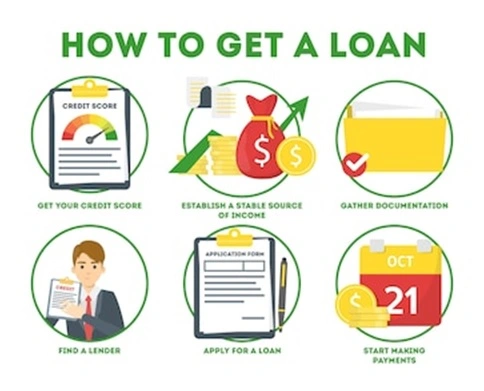When you take out a loan, you’ll be given a term for how long you need to make payments on it. Loan length is an important piece of information, because it will influence the type of loan that you choose. Generally speaking, longer loans require higher monthly payments for the lender. However, lenders offer shorter loans with lower monthly payments as well. The way in which those costs are broken up is what determines if a loan has amortized payments or not.
There are many different types of loans that people can get when they need money fast. Some loan types may have more restrictions than others, but most have pros and cons that need to be considered before accepting one. If you’re considering getting a loan – whether personal, auto, student, or home equity – here is an introduction to some common types of loans and what they mean for your financial future.
What is an amortized loan?
A loan that is amortized is one in which the principal (the amount borrowed) is being paid down over time. Amortized loans are paid down by having a loan payment that includes both principal and interest. The amount of interest varies depending on the length of the loan, the current interest rate, and any other fees that are charged for the loan. The amount of the principal varies over time because it is being paid down a little bit each month.
In the beginning, the monthly payment will consist mostly of the interest, but over time the amount going towards the principal will increase. Amortization is the process of paying off a loan by making regular payments over a set period of time. In most cases, a portion of your monthly payment will go towards paying off the principal (the amount you initially borrowed) while the rest will go towards paying interest. Amortization typically refers to a loan, like a mortgage, where the amount you owe is decreasing over time.
Amortization schedule
Amortization refers to the process of paying off a loan, like a mortgage, where the amount you owe is decreasing over time. It is often referred to as the amortization schedule, which is a visual representation showing how much was borrowed, how much was repaid, and how much will be repaid over the course of the loan.
Graphs that show the amount you’ve borrowed and amount you still owe over time are known as amortization schedules. Each of these items have different names depending on the type of loan. – A loan amount is called principal. – A loan amount that has been paid off is called the principal balance. – The amount of interest due each month on a loan is called the interest amount.
Interest only loan
If you want to minimize the amount of upfront cash you need to come up with to get the loan, then a loan with interest only payments is an option. Interest only loans are typically only available for people with high credit scores, though. Interest only loans are a type of amortized loan where only the interest is paid each month and no payment is applied to the principal.
This means that the loan will be larger at the end of the term compared to what it would have been if regular payments had been made. However, if you qualify for an interest only loan, you may be able to get a lower monthly payment than you would with a different type of loan. This can be helpful if you have trouble qualifying for a loan with regular payments or have limited cash flow. Be aware that interest only loans typically have higher interest rates than other types of loans, which may increase your payment amount over time.
Balloon loan
A balloon loan is an amortized loan where the borrower has to pay the entire amount of the loan at the end of the term. It may be helpful to think of a balloon loan like a mortgage with a short term. Balloon loans don’t have regular monthly payments, but a lump-sum payment is typically due at the end of the term.
Balloon loans are sometimes used to finance a car purchase or other large purchase, but they should be avoided for general borrowing. Balloon loans are riskier for the lender because there is no regular payment. Sometimes balloon loans will have a balloon payment that is significantly higher than the original loan amount.
Graduated payment loan
A graduated payment loan is used to pay off a large loan, like a student loan, over a longer period of time. The payments start lower and increase every two or three years, which helps the borrower make payments over a longer period of time. These types of loans have lower monthly payments in the beginning, but they can be very hard to pay off quickly once the payments increase down the line.
Graduated payment loans will typically have a higher interest rate than a standard loan, so they should only be used under certain circumstances. People are often advised against using a graduated payment loan if they can get a regular loan with a lower interest rate.
Types of amortized loans
There are many different types of amortized loans that people can get when they need money. Each loan type has a different term and repayment schedule. The best loan for you will depend on your financial situation and what type of loan will work best for your specific situation. – Personal loans – A personal loan is a loan you get from a private lender, such as a family member or a friend. These loans are usually unsecured (without collateral), which means that you don’t have to put up any property or other assets as collateral if you don’t have a great credit score.
They are quick and usually easy to get, but they tend to have high interest rates. – Student loans – Although they may not be the most ideal loan, they do have low interest rates, which makes them a relatively good option for some people. – Auto loans – If you need to buy a car and don’t have enough money for a down payment, an auto loan may be a good option for you. – Home equity loans – A home equity loan is a type of amortized loan where you borrow money against the value of your home. – Credit cards – While they are technically a type of amortized loan, credit cards are risky for people with low or bad credit. If you want to get a cash advance on a credit card, you will likely be charged a very high interest rate. – Personal loans, student loans, auto loans, and home equity loans are all amortized loans.
How to calculate amortization
The easiest way to calculate the amortization, or amount of time it will take to pay off a loan, is to use a calculator. – Interest rate: The interest rate determines the amount of money the lender will make off the loan. The higher the interest rate, the more expensive the loan will be. – Loan amount: The loan amount is the total amount of money you are borrowing. – Loan term: The loan term is the amount of time it will take to pay off the loan. –
Monthly payment: The monthly payment is the amount of money you pay each month to finish paying off the loan. – Example: If you borrow $15,000 at 9% interest with a loan term of 10 years and make monthly payments of $250, it will take you 6 years and 5 months to pay off the loan. – Example: If you borrow $15,000 at 9% interest with a loan term of 10 years and make monthly payments of $250, it will take you 6 years and 5 months to pay off the loan.
Floating-rate loans
A floating-rate loan is a type of amortized loan that has an interest rate that changes over time. Floating-rate loans start out with a lower interest rate to attract borrowers and slowly increase over time. Floating-rate loans are sometimes used as a hedge against inflation, because they will increase as inflation rises. – Typically, floating-rate loans have higher interest rates than fixed-rate loans. – Most business loans are floating-rate loans. – Examples: A mortgage, a car loan, a student loan
Bottom line
Amortized loans are a type of loan where the principal and interest are paid off over time. The calculations for how long it will take to pay off a loan are very straightforward and easy to understand. Amortized loans are helpful for the borrower because they are more likely to be able to make their monthly payments.






7 thoughts on “Amortized Loans: A Brief Guide to Loan Types”
Wow, wonderful weblog structure! How long have you been blogging for?
you make blogging look easy. The full glance of your site is magnificent,
let alone the content! You can see similar here najlepszy sklep
Your point of view caught my eye and was very interesting. Thanks. I have a question for you.
Your point of view caught my eye and was very interesting. Thanks. I have a question for you.
I don’t think the title of your article matches the content lol. Just kidding, mainly because I had some doubts after reading the article.
Your point of view caught my eye and was very interesting. Thanks. I have a question for you.
Thanks for sharing. I read many of your blog posts, cool, your blog is very good.
I don’t think the title of your article matches the content lol. Just kidding, mainly because I had some doubts after reading the article.